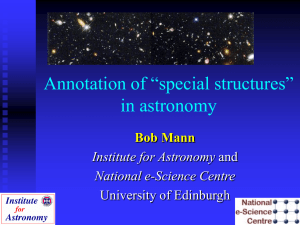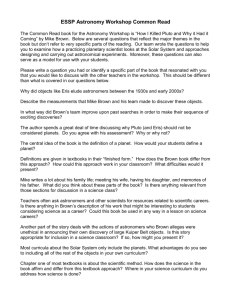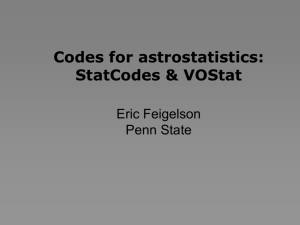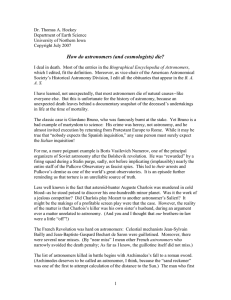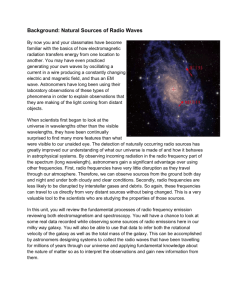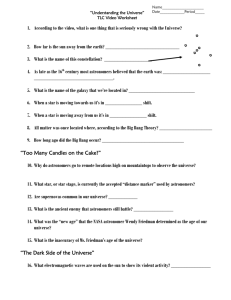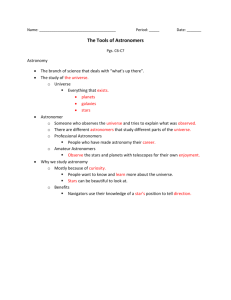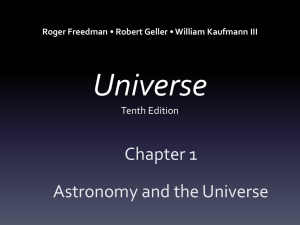Lesson Template
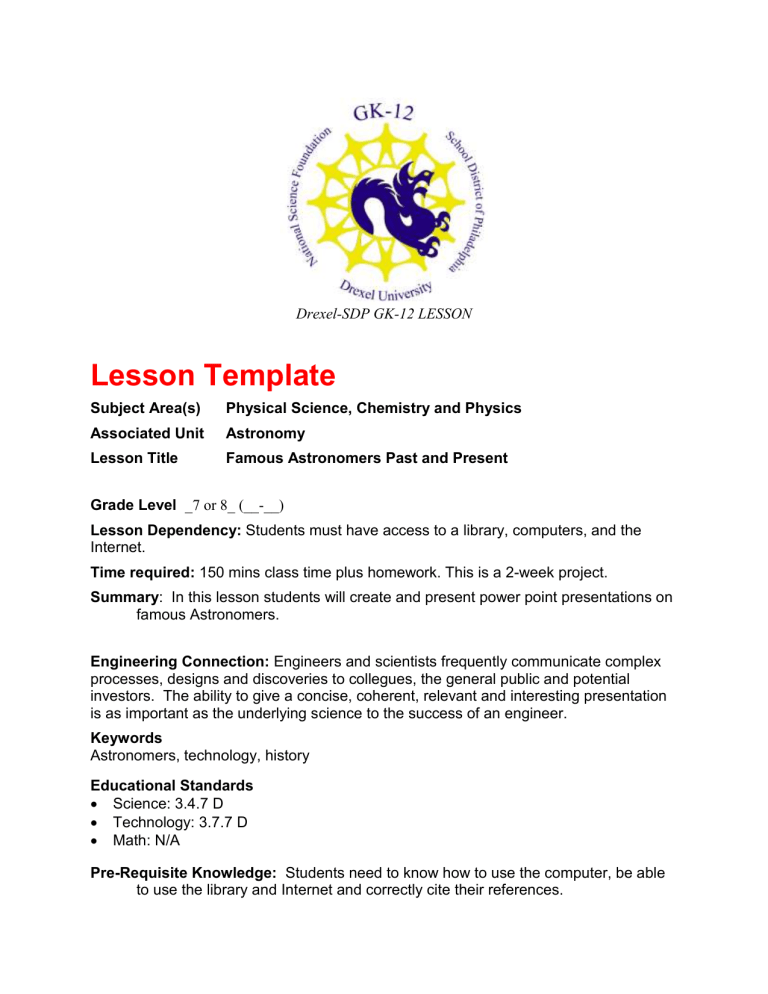
Drexel-SDP GK-12 LESSON
Lesson Template
Subject Area(s) Physical Science, Chemistry and Physics
Associated Unit Astronomy
Lesson Title Famous Astronomers Past and Present
Grade Level _7 or 8_ (__-__)
Lesson Dependency: Students must have access to a library, computers, and the
Internet.
Time required: 150 mins class time plus homework. This is a 2-week project.
Summary : In this lesson students will create and present power point presentations on famous Astronomers.
Engineering Connection: Engineers and scientists frequently communicate complex processes, designs and discoveries to collegues, the general public and potential investors. The ability to give a concise, coherent, relevant and interesting presentation is as important as the underlying science to the success of an engineer.
Keywords
Astronomers, technology, history
Educational Standards
Science: 3.4.7 D
Technology: 3.7.7 D
Math: N/A
Pre-Requisite Knowledge: Students need to know how to use the computer, be able to use the library and Internet and correctly cite their references.
Learning Objectives
After this lesson, students should be able to:
List the selected Astronomers and restate biographical information.
Discuss the major accomplishments of each of the selected Astronomers
Describe the technology used or designed by each of the Astronomers
Sketch the model of the universe each Astronomer proposed if applicable
Create a power point presentation
Introduction / Motivation
This activity is intended to provide an historical perspective on the study of our universe.
Science and engineering has evolved over time. Our understanding of our solar system and the greater universe has been influenced by the technology of a given era and the religious and political beliefs of the practitioners of science from that era. The current body of scientific knowledge has been gained through the attempts of men and women to explain the workings of nature and the defense of their ideas.
Lesson Background & Concepts for Teachers
Lesson Structure:
1. Students should be introduced to the list of astronomers. This list should reflect the class size as well as the curriculum guidelines. As a bare minimum the following names should be included: Aristotle, Ptolemy, Aristarchus of Samos,
Copernicus, Galileo, Kepler, Newton, Tycho Brahe, William Herschell, John
Couch Adams and Urbain Le Verrier, Einstein, Hubble, Hans Bethe
2. In class (at the library, computer room, or laptop cart) every student will have to research these Astronomers, and submit a brief summary answering the following questions: (this ensures all students have the basic information) a. Who was this person? b. What did this person discover/design/contribute to the field of astronomy?
c. Where did they live?
d. When were they alive? Include a brief description of the time period, not just dates. Were they contemporaries of other astronomers? Did they collaborate or base their theories on other Astronomers work?
e. Why were they interested in Astronomy? What motivated their work?
f. How did they make their contribution? Did they design/observe/calculate or all of the above to arrive at their discovery?
At this point it is all right to use Wikipedia or other Internet resources. The students are expected to reference where they got their information. To reinforce the “no copy and paste” rule we had the students hand write the information on note cards and bound them with a ring. This way they
2
could study from the cards later or use them in constructing an outline for the presentation.
3. After the note cards have been assessed by the teacher for correctness, they should be returned to the students. (We gave them a grade)
The students will be broken up into groups of 2 and assigned one of the
Astronomers from the list. Each group should then use their note cards to make an outline of their presentation. The outlines should express all the information for the presentation. It should be very detailed so that the students know what they are going to talk about. It should also reflect the organization of the information in the talk. If images are going to be used to support an idea, it should be noted in the outline. The presentation does not have to follow the organization of the note cards. They can organize the information to tell a story and we encouraged the students to take a perspective. (For example, the
Church’s influence on scientific thought during the Renaissance.) They are also encouraged to find more details to support their perspective. (This was very difficult for the students because they already did the note cards, they resisted the idea that the outline was different and in addition to the information already gathered.) The outlines have to be turned in for a grade. (see attached outline for reference)
4. Once the outlines are approved the students were asked story board their presentation. This is a short exercise to help them spatially organize their presentation and get an idea of how many slides they will need.
To make the storyboard we used plain white computer paper. Each paper is a slide. The rules for laying out a slide are as follows: a. Stick to one idea per slide. b. No more than 2-3 bullet points or phrases per slide c. 1-2 supporting images per slide d. References for the information should be at the bottom of the slide
They should sketch what they want the slide to look like. Where is the text going and where are the pictures? What is the purpose of the slide? We are no longer looking for more information but thinking about how we want to present the story.
5. Now they can use Power Point to make the slides. Students are given class time to work on their presentations on the computers. The final presentations should have the following organization: a. Title slide: Title of the presentation, and names of the presentation b. Outline of the talk: very brief one or two words indicating the flow of the presentation c. Body of the presentation d. Summary e. Questions (from the audience)
3
The students will have to discuss the slides without “reading them”. They should only put the most importation information on the slides. This will make the presentation flow better and if they are nervous they can use note cards to remind them of what they are going to say.
Lesson Closure
The students then present their presentations to the rest of the class. Attached is the rubric for the final presentation. They were limited to 10 mins for the talk and 5 minutes for questions. The class gets additional participation points for asking questions.
Assessments
Pre-lesson assessment: There was no pre-lesson assessment.
Post Introduction assessment: Note cards were graded and students were asked to correct mistakes (rubric attached)
Mid Lesson assessment: Outlines were graded (rubric attached)
Mid lesson assessment: Storyboards were not graded, but the teacher circulated to ensure the students understood what they were doing.
Final Assessment: Students presented their presentations (rubric attached)
Lesson Extension Activities
Additional Multimedia Support
References
List of Astronomers and some basic information on their contributions to
Astronomy. http://cass.ucsd.edu/public/tutorial/History.html
Attachments presentation style.pdf
Other
Redirect URL
Owner
Drexel University GK-12 Program
Contributors
Jennifer Atchison, Dorothea Stanley
Copyright
Copyright 2008 Drexel University GK-12 Program. Reproduction permission is granted for nonprofit educational use.
4
